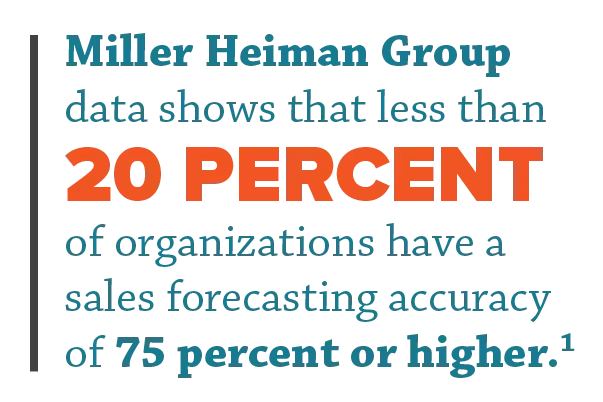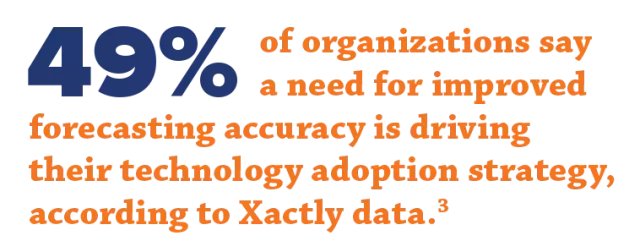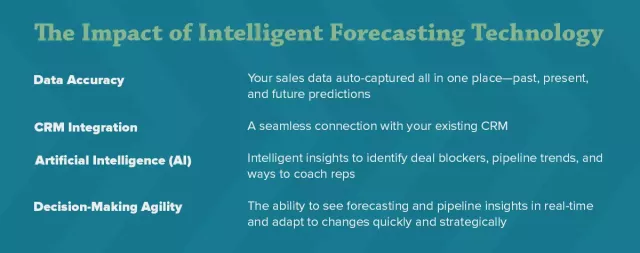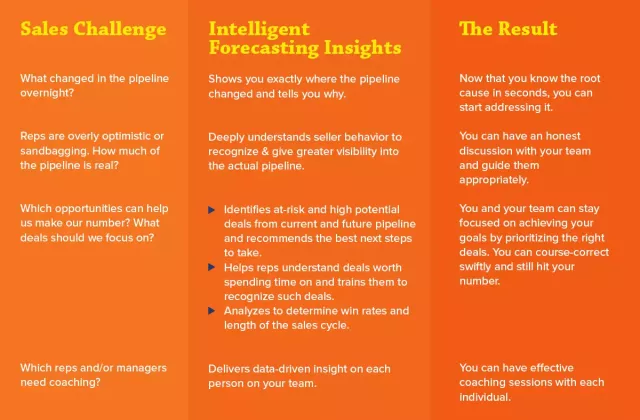
Imagine this: It’s a Friday afternoon. Your sales pipeline looks healthy, deals are moving along smoothly, and you’re on track with your revenue goals. Feeling satisfied that your team is on track, you log off and head home.
Then, over the weekend, disaster strikes. First thing Monday morning you log back on, and seemingly overnight, your projections have changed, and somehow, you’re off by hundreds of thousands of dollars. Now you’re scrambling. Not only are you trying to get your forecast back on track, but you also have to explain to your executive board what’s going on when you’re not quite sure what threw off your numbers in the first place.
Unfortunately, this isn’t just a nightmare you can wake up from, shake off, and carry on with your day. It’s a reality that today’s sales leaders are facing more often than you think.
And worse yet, it doesn’t take a global disaster to create this kind of uncertainty and stress around your forecasting.
Today’s markets shift quickly, economies are volatile, and global changes can happen at any moment. Everywhere you look, you hear about adjusting to a “new normal.” But it’s difficult to achieve a “new normal” when that definition is a moving target.
As a result, businesses are struggling to maintain a sense of stability and security while accurately predicting their revenue numbers. And it’s even harder to adapt to outside changes and disruptions quickly when you don’t have the right tools and technology on hand.
Expecting the Unexpected
There are two ways you can respond to unexpected forecasting disruptions. It all depends on the data you have available and the technology you use to make them more effective.
Option 1: Manual Forecasting
If you’re managing your forecasting manually, it’s going to be an uphill battle to fix your revenue projections in any situation, including the nightmare scenario we mentioned earlier. Sure, you can go deal by deal in your CRM, or export into spreadsheets and scour them line by line to uncover where that projected revenue went, but realistically, no one has that much time, and your spreadsheets can only tell you so much.
Chances are, even if you keep meticulous versions of your forecast spreadsheets, you won’t have enough information at hand to pinpoint the exact causes or underlying issues that contributed to the lost revenue. And it’s likely out of date just a few minutes after you hit the export button.
Forecasting manually ultimately puts you at a disadvantage because you have limited visibility into what’s working and harming your business. When disruptions occur, there are little to no insights available to guide your decision-making, and you're left to navigate based on gut instinct and guesswork.
Option 2: Automated, Intelligent Forecasting Technology
Your second option is a much easier path to be on. Automated, intelligent forecasting opens the door to more visibility and control over your revenue predictions.
With automated forecasting technology, you have a single source of truth for all of your revenue forecasts. There’s no need to save hundreds of spreadsheets to track changes and compare trends over time. When your forecast is backed by real data directly from your CRM, all the key stakeholders from Finance to the Board can trust your number and solidify their confidence in your revenue teams and processes.
All intelligent forecasting solutions should also integrate with your existing CRM to help you track deals more effectively. As your sales team updates deals in the CRM, that data can seamlessly carry over to your forecast so it’s up-to-date at all times.
Most importantly, technology like Xactly Forecast is AI-enabled. You can’t fix problems or identify common slowdowns in your sales cycle if you don’t know they’re there. With intelligent forecasting, you can look at trends in your sales cycle, seller behavior, deal blockers, and more to increase your forecasting accuracy and improve manager coaching, processes, and revenue-driving strategies.
Paving an Easier Forecasting Path
So let’s once more consider our forecasting nightmare scenario from earlier. Continuing with what you’ve always done and using manual forecasting, you’re still scouring through spreadsheets looking for any clue as to why deals fell through or are being pushed to the next quarter.
AI-enabled forecasting technology allows you to easily access in-depth reports to pinpoint the exact cause(s) of forecast changes, including:
- Individual Deal Progression: Was there a lapse in communication between the rep and the prospect that caused the deal to slow down?
- External Factors: Are there external economic factors that have caused prospects to pause the buying process?
- Sales Cycle Trends: Do your deals tend to slow down at certain points in the selling cycle, or are there product sales that struggle to progress more than others?
With this data, you can not only understand changes to your forecast, but you can identify underlying performance factors across your sales team. It can show you where you need to improve coaching, provide additional selling support, adjust selling incentives and processes, and more.
The result? You’re able to create a stronger, more accurate forecast by optimizing the rest of your organization—your sales team is well trained, processes are designed efficiently, and revenue is generated more effectively.
The Power of AI-enabled Forecasting & Pipeline Analytics
Disruptions are unavoidable in today’s fast-paced world, and change is truly the only constant for businesses. Having the ability to respond with agility and confidence is essential, and with intelligent forecasting, you’re equipped to tackle any challenge. Here’s how AI-enabled forecasting and pipeline analytics help you adapt in the face of common disruptions.
Making Intelligent Forecasting a Reality
Your sales forecast plays a critical role in your success and is used across your organization to make a myriad of strategic decisions. But it’s stressful and frustrating when you aren’t able to maintain it with accuracy, especially when change is happening so quickly and you don’t have the right insights available to give you a comprehensive view of your revenue pipeline health.
Sales churn, new competitors, and market changes are all disruptions that happen unexpectedly. And in today’s world, you have to expect that they’ll happen (likely more than once, or at the same time) and prepare for it. With the right forecasting tools and intelligent insights in hand, you can be confident that your team is equipped to hit revenue targets, regardless of selling conditions.
To learn more about how you can use intelligent, AI-enabled forecasting technology to improve your forecasting, download our guide, “How an Accurate Sales Forecast Makes You a Hero to Your Entire Company.”
Sources
- Miller Heiman Group
- Gartner
- Xactly State of Global Enterprise Sales Performance 2021
- CSO Insights







